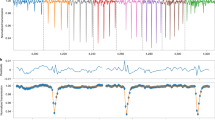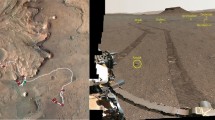Abstract
We revisit the idea of ‘terraforming’ Mars — changing its environment to be more Earth-like in a way that would allow terrestrial life (possibly including humans) to survive without the need for life-support systems — in the context of what we know about Mars today. We want to answer the question of whether it is possible to mobilize gases present on Mars today in non-atmospheric reservoirs by emplacing them into the atmosphere, and increase the pressure and temperature so that plants or humans could survive at the surface. We ask whether this can be achieved considering realistic estimates of available volatiles, without the use of new technology that is well beyond today’s capability. Recent observations have been made of the loss of Mars’s atmosphere to space by the Mars Atmosphere and Volatile Evolution Mission probe and the Mars Express spacecraft, along with analyses of the abundance of carbon-bearing minerals and the occurrence of CO2 in polar ice from the Mars Reconnaissance Orbiter and the Mars Odyssey spacecraft. These results suggest that there is not enough CO2 remaining on Mars to provide significant greenhouse warming were the gas to be emplaced into the atmosphere; in addition, most of the CO2 gas in these reservoirs is not accessible and thus cannot be readily mobilized. As a result, we conclude that terraforming Mars is not possible using present-day technology.
This is a preview of subscription content, access via your institution
Access options
Access Nature and 54 other Nature Portfolio journals
Get Nature+, our best-value online-access subscription
$29.99 / 30 days
cancel any time
Subscribe to this journal
Receive 12 digital issues and online access to articles
$119.00 per year
only $9.92 per issue
Buy this article
- Purchase on Springer Link
- Instant access to full article PDF
Prices may be subject to local taxes which are calculated during checkout

adapted from ref. 16, Elsevier

NASA/JPL-Caltech/JHUAPL/Univ. of Arizona

Similar content being viewed by others
References
Sagan, C. The long winter model of Martian biology: A speculation. Icarus 15, 511–514 (1971).
McKay, C. P., Toon, O. B. & Kasting, J. F. Making Mars habitable. Nature 352, 489–496 (1991).
Musk, E. Becoming a multi-planet species. International Astronautical Congress (2017); https://www.youtube.com/watch?v=cj3OgrvvBpE
Lovelock, J. & Allaby, M. Greening of Mars (Warner Books, New York, 1985).
Gerstell, M. F., Francisco, J. S., Yung, Y. L., Boxe, C. & Aaltonee, E. T. Keeping Mars warm with new super greenhouse gases. Proc. Natl Acad. Sci. USA 98, 2154–2157 (2001).
Marinova, M. M., McKy, C. P. & Hashimoto, H. Radiative-convective model of warming of Mars with artificial greenhouse gases. J. Geophys. Res. https://doi.org/10.1029/2004JE002306 (2005).
Ramirez, R. M. et al. Warming early Mars with CO2 and H2. Nat. Geosci. 7, 59–63 (2014).
James, P. B., Kieffer, H. H. & Paige, D. A. in Mars (eds Kieffer, H. H. et al.) 934–968 (Univ. Arizona Press, Tucson, 1992).
Thomas, P., Squyres, S., Herkenhoff, K., Howard, A. & Murray, B. in Mars (eds Kieffer, H. et al.) 767–795 (Univ. Arizona Press, Tucson, 1992).
Phillips, R. J. et al. Massive CO2 ice deposits sequestered in the south polar layered deposits of Mars. Science 332, 838–841 (2011).
Bierson, C. J. et al. Stratigraphy and evolution of the buried CO2 deposit in the Martian south polar cap. Geophys. Res. Lett. 43, 4172–4179 (2016).
Hobbs, P. V. Ice Physics (Clarendon, Oxford, 1974).
Dobrovolskis, A. & Ingersoll, A. P. Carbon dioxide–water clathrate as a reservoir of CO2 on Mars. Icarus 26, 353–357 (1975).
Stewart, S. T. & Nimmo, F. Surface runoff features on Mars: Testing the carbon dioxide formation hypothesis. J. Geophys. Res. 107, 7–12 (2002).
Sagan, C. Liquid carbon dioxide and the Martian polar laminas. J. Geophys. Res. 78, 4250–4251 (1973).
Zent, A. P., Fanale, F. P. & Postawko, S. E. Carbon dioxide: Adsorption on palagonite and partitioning in the Martian regolith. Icarus 71, 241–249 (1987).
Jänchen, J., Morris, R. V., Bish, D. L., Janssen, M. & Hellwig, U. The H2O and CO2 adsorption properties of phyllosilicate-poor palagonitic dust and smectites under martian environmental conditions. Icarus 200, 463–467 (2009).
Christensen, P. R. Regional dust deposits on Mars: Physical properties, age, and history. J. Geophys. Res. 91, 3533–3545 (1986).
Cannon, K. M., Parman, S. W. & Mustard, J. F. Primordial clays on Mars formed beneath a steam or supercritical atmosphere. Nature 552, 88–91 (2017).
Ehlmann, B. L. & Edwards, C. S. Mineralogy of the Martian surface. Annu. Rev. Earth Planet. Sci. 42, 291–315 (2014).
Pollack, J. B., Kasting, J. F., Richardson, S. M. & Poliakoff, K. The case for a wet, warm climate on early Mars. Icarus 71, 203–224 (1987).
Kahn, R. The evolution of CO2 on Mars. Icarus 62, 175–190 (1985).
Niles, P. B. et al. Geochemistry of carbonates on Mars: Implications for climate history and nature of aqueous environments. Space Sci. Rev. 174, 301–328 (2013).
Edwards, C. S. & Ehlmann, B. L. Carbon sequestration on Mars. Geology 43, 863–866 (2015).
Wray, J. J. et al. Orbital evidence for more widespread carbonate-bearing rocks on Mars. J. Geophys. Res. Planets 121, 652–677 (2016).
Bandfield, J. L., Glotch, T. D. & Christensen, P. R. Spectroscopic identification of carbonate minerals in the Martian dust. Science 301, 1084–1086 (2003).
Michalski, J. R. & Niles, P. B. Deep crustal carbonate rocks exposed by meteor impact on Mars. Nat. Geosci. 3, 751–755 (2010).
Lundin, R. et al. Solar forcing and planetary ion escape from Mars. Geophys. Res. Lett. 35, 09203 (2008).
Jakosky, B. M. et al. Loss of the Martian atmosphere to space: Present-day loss rates determined from MAVEN observations and integrated loss through time. Icarus (in the press).
Luhmann, J. G., Johnson, R. E. & Zhang, M. H. G. Evolutionary impact of sputtering of the Martian atmosphere by O+ pickup ions. Geophys. Res. Lett. 19, 2151–2154 (1992).
Chassefiere, E., Langlais, B., Quesnel, Y. & Leblanc, F. The fate of early Mars’ lost water: The role of serpentinization. J. Geophys. Res. 118, 1123–1134 (2013).
Jakosky, B. M. Mars volatile evolution: Evidence from stable isotopes. Icarus 94, 14–31 (1991).
Webster, C. R. et al. Isotope ratios of H, C, and O in CO2 and H2O of the Martian atmosphere. Science 341, 260–263 (2013).
Phillips, R. J. et al. Ancient geodynamics and global-scale hydrology on Mars. Science 291, 2587–2591 (2001).
Jakosky, B. M. et al. Mars’ atmospheric history derived from upper-atmosphere measurements of 38Ar/36Ar. Science 355, 1408–1410 (2017).
Mole, R. A. Terraforming Mars with four war-surplus bombs. J. Brit. Interplanet. Soc. 48, 321–324 (1995).
Leopold, T. Elon Musk’s new idea: Nuke Mars. CNN (2015); https://www.cnn.com/2015/09/11/us/elon-musk-mars-nuclear-bomb-colbert-feat/index.html
Green, J. L. et al. A future Mars environment for science and exploration. Planetary Visions 2050 Workshop 1989 (2017).
Greeley, R. & Schneid, B. D. Magma generation on Mars: Amounts, rates, and comparisons with Earth, Moon, and Venus. Science 254, 996–998 (1991).
Tanaka, K. L. The stratigraphy of Mars. J. Geophys. Res. 91, E139–E158 (1986).
Jakosky, B. M. & Shock, E. L. The biological potential of Mars, the early Earth, and Europa. J. Geophys. Res. 103, 19359–19364 (1998).
Carr, M. H. Recharge of the early atmosphere of Mars by impact-induced release of CO2. Icarus 79, 311–327 (1989).
Kasting, J. F. CO2 condensation and the climate of early Mars. Icarus 94, 1–13 (1991).
Acknowledgements
This research was supported in part by NASA through the MAVEN and Mars Odyssey Thermal Emission Imaging System (THEMIS) projects. Thoughtful comments from M. Marinova are appreciated.
Author information
Authors and Affiliations
Contributions
B.M.J. carried out the atmospheric analyses and C.S.E. carried out the surface/subsurface analyses. Both authors contributed to the volatile inventory, integration and writing.
Corresponding author
Ethics declarations
Competing interests
The authors declare no competing interests.
Additional information
Publisher’s note: Springer Nature remains neutral with regard to jurisdictional claims in published maps and institutional affiliations.
Rights and permissions
About this article
Cite this article
Jakosky, B.M., Edwards, C.S. Inventory of CO2 available for terraforming Mars. Nat Astron 2, 634–639 (2018). https://doi.org/10.1038/s41550-018-0529-6
Received:
Revised:
Accepted:
Published:
Issue Date:
DOI: https://doi.org/10.1038/s41550-018-0529-6
This article is cited by
-
Boosting a practical Li-CO2 battery through dimerization reaction based on solid redox mediator
Nature Communications (2024)
-
Binuclear Cu complex catalysis enabling Li–CO2 battery with a high discharge voltage above 3.0 V
Nature Communications (2023)
-
Martian buildings: structural forms using in-place sources
Scientific Reports (2022)
-
Enabling Martian habitability with silica aerogel via the solid-state greenhouse effect
Nature Astronomy (2019)
-
Terraforming: synthetic biology’s final frontier
Archives of Microbiology (2019)



